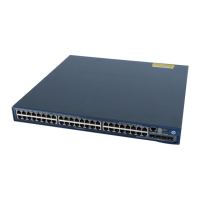73
Max age 2 × (hello time + 1 second)
HP does not recommend you to manually set the timers. Instead, you can use the stp bridge-diameter
command to set the network diameter, and let the network automatically adjust the three timers according
to the network size. When the network diameter is the default value, the three timers are also set to their
defaults.
Make this configuration on the common root bridge only, and then this configuration applies to all
devices on the entire switched network.
Follow these steps to configure the timers of MSTP:
Configure the forward delay timer
stp timer forward-delay time
Optional
1500 centiseconds (15 seconds)
by default.
Configure the hello timer
Optional
200 centiseconds (2 seconds) by
default.
Configure the max age timer
Optional
2000 centiseconds (20 seconds)
by default.
NOTE:
The length of the forward delay is related to the network diameter of the switched network. The larger the
network diameter is, the longer the forward delay should be. If the forward delay is too short, temporary
redundant paths might occur. If the forward delay is too long, network convergence might take a long time. HP
recommends that you use the default setting.
An appropriate hello time enables the device to quickly detect link failures on the network without using excessive
network resources. If the hello time is set too long, the device will mistake packet loss as a link failure and trigger
a new spanning tree calculation process. If the hello time is set too short, the device will frequently send repeated
configuration BPDUs, which adds to the device burden and wastes network resources. HP recommends that you
use the default setting.
If the max age time is too short, the network devices will frequently begin spanning tree calculations and might
mistake network congestion as a link failure. If the max age is too long, the network might fail to quickly detect
link failures and fail to quickly begin spanning tree calculations, reducing the auto-sensing capability of the
network. HP recommends that you use the default setting.
Configuring the timeout factor
The timeout factor is a parameter used to decide the timeout time in the following formula: Timeout time =
timeout factor × 3 × hello time.
After the network topology is stabilized, each non-root-bridge device forwards configuration BPDUs to the
downstream devices at the interval of hello time to determine whether any link is faulty. If a device does
not receive a BPDU from the upstream device within nine times the hello time, it assumes that the
upstream device has failed and starts a new spanning tree calculation process.
Sometimes a device might fail to receive a BPDU from the upstream device because the upstream device
is busy. If a spanning tree calculation occurs, the calculation can fail and also waste network resources.

